
T X 6 1 5 5 / T X 6 8 5
I N S T R U C T I O N M A N UA L
PA G E 9
Once the batteries are fully charged they can be left on the charger until they are needed.
Note:
1. When charging two battery packs, the battery in the front slot has priority and will be
charged first.
2. If the RED LED does not light when the battery is first inserted, the battery voltage may be too
low to begin a normal charge cycle. In this case simply leave the battery on the charger until the
charger has raised the battery voltage to an acceptable level. The RED LED will then light and the
normal charge cycle will begin.
3. If the LED flashes RED or Amber while charging, a fault condition has been detected. Try
removing the battery then reinserting it. If the LED continues to flash, remove the battery and
contact your GME service centre for advice.
Battery Low Alert
When the battery icon blinks on the radio’s display, the battery level is low and the battery pack
should be recharged. If the battery is not charged, an audio tone will then sound to warn the user
that the battery is almost discharged.
Battery Usage
The time taken to discharge the battery pack will depend on how you use the radio. The battery
pack supplied is powerful enough for a full day’s use under average conditions.
Conserving Battery Power
The radio has built-in power saving features to help you get the maximum amount of time between
charges from your Li-Ion battery pack. If you need to operate your radio in a situation where you
require maximum battery life (e.g. a remote site where there is no convenient recharging facility
nearby) the following hints can greatly reduce the amount of power drawn from the battery pack.
–
Standby Mode:
The radio will automatically enter the ‘Standby’ mode when it is inactive (i.e. not transmitting or
receiving signals).
While in Standby mode it will still check for incoming signals but it will draw considerably less
power from the battery pack. As soon as a signal is heard or the keys are pressed the radio will
‘wake up’ again. This Standby mode is automatic and by itself can extend the battery life by
many hours.
–
Use CTCSS/DCS:
If you are expecting to receive signals on a busy channel, you can program that channel for
CTCSS/DCS operation and get the other person to call you using the same CTCSS/DCS tone. Your
radio will then remain in Standby and ignore all other signals until your selected CTCSS/DCS tone
is received.
–
Avoid Scanning:
The radio draws more power from the battery pack when scanning than when monitoring a
single channel. This is because it must ‘wake up’ more often to monitor each channel for activity.
You can ‘squeeze’ that extra bit of life from the battery pack by avoiding any unnecessary
scanning. In addition, scanning increases the chance of finding a signal thereby keeping the
receiver ‘awake’ and the squelch open more often.
–
Use Low Transmit Power:
The transmitter has both high and low power settings. If you are only operating over short
distances, are in a reasonably high location or are close to a local repeater, try using the Low
transmitter power setting. This reduces the transmitter power to 1 watt effectively doubling the
talk time available.






































